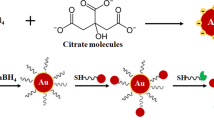Abstract
Demand for developing novel delivery system for cancer treatment has increased due to the side effects present in intravenous injection of l-asparaginase. Nanoparticles are used for delivering the drugs to its destination in cancer cure. Nanobiocomposite of zinc oxide nanoparticles conjugated with l-asparaginase was produced by Aspergillus terreus and was confirmed using maximum UV–Vis absorption at 340 nm in the present work. The presence of functional groups like OH, C–H, –C=N and C=O on the surface of nanobiocomposite was found from Fourier transform infrared spectrum analysis. Size of the produced nanocomposite was found in the range of 28–63 nm using scanning electron microscope. The crystalline nature of the synthesized nanobiocomposites was confirmed by X-ray diffraction analysis. The presence of zinc oxide on synthesized nanobiocomposite was confirmed by energy dispersive spectrum analysis. The anti-cancerous nature of the synthesized zinc oxide conjugated l-asparaginase nanobiocomposite on MCF-7 cell line was studied using MTT assay. The viability of the MCF-7 cells was decreased to 35.02 % when it was treated with l-asparaginase conjugated zinc oxide nanobiocomposite. Hence it is proved that the synthesized nanobiocomposites of zinc oxide conjugated l-asparaginase has good anti-cancerous activity.






Similar content being viewed by others
References
Boisselier E, Astruc D. Gold nanoparticles in nanomedicine: preparation, imaging, diagnostics, therapies and toxicit. Chem Soc Rev. 2009;38:1759–82.
Moudgil S, Ying J. Calcium-doped organosilicate nanoparticles as gene delivery vehicles for bone cells. Adv Mater. 2007;19:3130–5.
Maeda H, Wu J, Sawa T, Matsumura Y, Hori K. Tumor vascular permeability and the EPR effect in macromolecular therapeutics: a review. J Control Release. 2000;65:271–84.
Danhier F, Feron O, Preat V. To exploit the tumor microenvironment: passive and active tumor targeting of nanocarriers for anti-cancer drug delivery. J Control Release. 2010;148:135–46.
Kocbek P, Obermajer N, Cegnar M, Kos J, Kristl J. Targeting cancer cells using PLGA nanoparticles surface modified with monoclonal antibodies. J Control Release. 2007;120:18–26.
Cho KJ, Moon HT, Park GE, Jeon OC, Byun Y, Lee YK. Preparation of sodium deoxycholate (DOC) conjugated heparin derivatives for inhibition of angiogenesis and cancer cell growth. Bioconjug Chem. 2008;19:1346–51.
Wriston JC Jr, Yellin TO. L-asparaginase—a review. Adv Enzymol Relat Areas Mol Biol. 1973;39:185–248.
Mathews M, Brown H. Isolation of two L-asparaginases from Guinea pig liver. Enzyme. 1974;17:276–86.
Siechiechowicz K, Ireland R. Isolation and properties of an asparaginase from leaves of Pisum sativum. Phytochemistry. 1989;28:2275–9.
Baskar G, Renganathan S. Optimization of culture conditions and bench scale production of L-asparaginase by submerged fermentation of Aspergillus terreus MTCC 1782. J Microbiol Biotechnol. 2012;22:923–9.
Nakamura CT, Wilkinson R, Woodruff K. Pancreatitis and perotitis following therapy with L-asparaginase. Int Pedeatrics. 1999;14:25–7.
Haley EE, Fischer GA, Welch AD. The requirement for l-asparagine of mouse leukemia cells L5178Y in culture. Cancer Res. 1961;21:532–6.
Mitchell I, Hoogendroorn H, Giles AR. Increased endogenous thrombin generation in children with acute lymphoblastic leukemia: risk of thrombotic complications in L-asparaginase induced antithrombin III deficiency. Blood. 1994;83:386–91.
Ryter SW, Kim HP, Hoetzel A, Park JW, Nakahira K, Wang X, Choi AM. Mechanisms of cell death in oxidative stress. Antioxid Redox Signal. 2007;9:49–89.
Zhang Y, Chen W, Wang SP, Liu YF, Pope C. Phototoxicity of zinc oxide nanoparticle conjugates in human ovarian cancer. J Biomed Nanotechnol. 2008;4:432–8.
Berridge MV, Herst PM, Tan AS. Tetrazolium dyes as tools in cell biology: new insights into their cellular reduction. Biotechnol Annu Rev. 2005;11:127–52.
Mosmann T. Rapid colorimetric assay for cellular growth and survival: application to proliferation and cytotoxicity assays. J Immunol Methods. 1983;65:55–63.
Pranav VB, Dilliganesh T, Vasanth Kumar M, Chamundeeswari M, Baskar G. Biological synthesis and characterization of intracellular gold nanoparticles using biomass of Aspergillus fumigatus. Bull Mater Sci. 2013;36:1201–5.
Arakelova ER, Grigoryan SG, Arsenyan FG, Babayan NS, Grigoryan RM, Sarkisyan NK. In vitro and in vivo anticancer activity of nanosize zinc oxide composites of doxorubicin. Int J Med Health Pharm Biomed Eng. 2014;8:33–8.
Zheng J, Schnurr T, Dunlap K, Das D, Duffy L. Effect of zinc oxide nanoparticles on neuroblastoma SH-SY5Y cells. Am J Biochem Biotechnol. 2014;10:116–24.
Author information
Authors and Affiliations
Corresponding author
Rights and permissions
About this article
Cite this article
Baskar, G., Chandhuru, J., Sheraz Fahad, K. et al. Anticancer activity of fungal l-asparaginase conjugated with zinc oxide nanoparticles. J Mater Sci: Mater Med 26, 43 (2015). https://doi.org/10.1007/s10856-015-5380-z
Received:
Accepted:
Published:
DOI: https://doi.org/10.1007/s10856-015-5380-z




